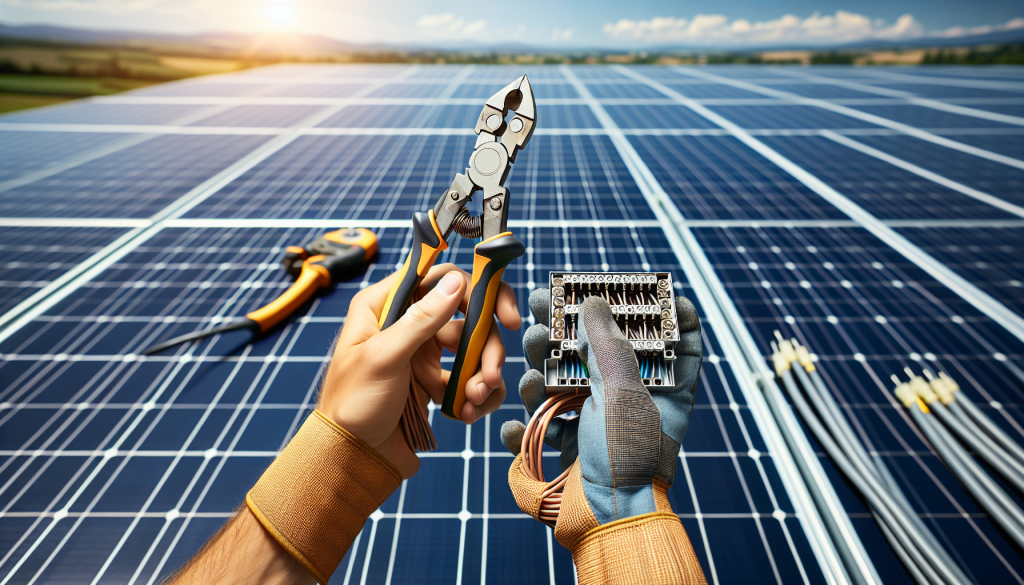How To Wire Solar Panels
As an Amazon Associate, I earn from qualifying purchases, at no additional cost to you. Disclaimer
Growing interest in renewable energy sources has led many individuals, like me, to explore the world of solar power. With the potential to reduce our carbon footprint and save on electricity bills, installing solar panels has become an appealing option. However, the process of wiring solar panels can seem daunting for those new to the field. In this article, I will provide a step-by-step guide that simplifies the wiring process, ensuring a successful and efficient connection. Whether you’re a DIY enthusiast or a novice in solar energy, this article will equip you with the knowledge and confidence to wire solar panels effectively. So, let’s get started!

Understanding Solar Panel Configuration
Solar panels are a great way to harness the power of the sun and generate clean, renewable energy. But before you can start enjoying the benefits of solar power, it’s important to understand how solar panel configuration works. This comprehensive guide will walk you through the basics of solar panels, the different types available, and how to wire them for optimum performance.
Basics of Solar Panels
Solar panels, also known as photovoltaic (PV) panels, consist of multiple solar cells made of silicon. These cells absorb sunlight and convert it into electricity through the photovoltaic effect. When the sun’s rays hit the solar cells, electrons are released, creating a flow of electricity.
Solar panels are typically made up of interconnected solar cells, arranged in a rectangular configuration. They come in various sizes and wattages, depending on their intended use and energy output. Understanding the basics of solar panels is crucial in determining the right configuration for your energy needs.
Types of Solar Panels
There are several types of solar panels available on the market, each with its own advantages and disadvantages. The three most common types are monocrystalline, polycrystalline, and thin-film solar panels.
Monocrystalline panels: These panels are made from a single crystal structure, resulting in higher efficiency and a sleek black appearance. Monocrystalline panels are more expensive but offer greater power output in limited space.
Polycrystalline panels: Made from multiple crystal structures, polycrystalline panels are less efficient but more affordable than monocrystalline panels. They have a blue hue and are a popular choice for larger installations.
Thin-film panels: Thin-film panels are made by depositing a thin layer of semiconductor material on a substrate. They are less efficient and require more space compared to crystalline panels but are often more flexible and aesthetic.
Understanding the differences between these types of solar panels will help you make an informed decision when selecting the right panels for your specific energy needs.
Understanding Solar Panel Wiring Configuration
Solar panel wiring configuration plays a crucial role in maximizing the efficiency and performance of your solar power system. There are two primary wiring configurations: series wiring and parallel wiring.
Series wiring: In series wiring, solar panels are connected end-to-end, forming a string. The positive terminal of one panel is connected to the negative terminal of the next panel, creating a continuous circuit. This configuration increases the system voltage and is ideal when the distance between panels is long.
Parallel wiring: In parallel wiring, all the positive terminals of the panels are connected together, and all the negative terminals are connected together. This configuration keeps the system voltage consistent but increases the current capacity. Parallel wiring is useful when panels are located close to each other.
Understanding how solar panel wiring configuration affects voltage, current, and overall system performance is essential for designing an efficient and effective solar power system.
Assessing Your Energy Needs
Before diving into the installation process, it’s crucial to assess your energy needs accurately. By calculating your energy consumption, determining optimum panel output, and understanding energy efficiency, you can ensure that your solar power system meets your requirements.
Calculating Energy Consumption
Start by evaluating your current energy consumption. Look at your monthly electricity bills and identify your average kilowatt-hour (kWh) usage. This will give you a baseline to determine how many solar panels you’ll need to meet your energy needs.
Remember to factor in any expected changes in energy usage, such as the addition of energy-intensive appliances or an increase in household members. By accurately calculating your energy consumption, you can avoid under- or over-sizing your solar power system.
Determining Optimum Panel Output
Once you have a clear understanding of your energy consumption, you can determine the optimum panel output required to offset your electricity usage. The panel output is typically measured in watts (W) and represents the power generated by a solar panel under specific conditions.
Consider factors such as the number of sunlight hours in your location, the orientation and tilt angle of your panels, shading, and other environmental variables that might impact panel performance. This information will guide you in selecting panels with the appropriate output capacity to meet your energy needs effectively.
Understanding Energy Efficiency
Energy efficiency plays a significant role in maximizing the benefits of your solar power system. By implementing energy-efficient practices and investing in energy-efficient appliances, you can reduce your overall energy consumption and make the most of the electricity generated by your solar panels.
Simple energy-saving measures, such as replacing traditional incandescent light bulbs with energy-efficient LED lights or improving the insulation of your home, can significantly impact your energy efficiency and reduce your reliance on the grid.
Understanding energy efficiency will not only help you make informed decisions about panel selection and sizing but also lead to long-term energy savings and a greener lifestyle.

Tools and Equipment Needed
To ensure a successful solar panel installation, you’ll need the right tools and equipment. Having a clear understanding of the necessary tools, selecting quality equipment, and considering safety gear are essential steps in preparing for your solar panel installation.
Identifying Necessary Tools
Before you embark on your installation project, make sure you have the following tools on hand:
Screwdriver and/or drill: These tools will be necessary for securing mounting brackets and attaching panels to the roof or ground.
Wire cutters and strippers: These tools are essential for cutting and stripping wires during the wiring process.
Junction box: A junction box will be needed to connect the wiring from the solar panels to the rest of the system.
Crimping tool: This tool is useful for connecting wires securely and ensuring a proper electrical connection.
Measuring tape and level: These tools will help you accurately measure and align the solar panels during the installation process.
Ladder or scaffolding: Depending on the height of your roof, you may need a ladder or scaffolding to access and install the panels safely.
Having these tools readily available will make your installation process easier and more efficient.
Selecting Quality Equipment
When it comes to solar panel installations, choosing high-quality equipment is crucial for long-term performance and reliability. Invest in reputable solar panels, inverters, and mounting hardware from trusted manufacturers.
Research the specifications, warranties, and customer reviews of different brands to ensure you select equipment that is best suited for your specific needs and budget. Quality equipment will not only provide better performance but also offer peace of mind knowing that your investment is built to last.
Safety Equipment Required for Installation
installing solar panels involves working at heights and dealing with potentially hazardous electrical connections. Therefore, it’s essential to prioritize safety throughout the installation process. Ensure you have the following safety equipment:
Safety harness and fall protection gear: When working on rooftops, use a safety harness and fall protection gear to prevent any accidents or injuries from falls.
Work gloves and protective eyewear: Protect your hands with work gloves and wear protective eyewear to guard against any potential hazards during installation.
Insulated tools: Using insulated tools for electrical connections can safeguard against electrical shocks and ensure safe working conditions.
Fire extinguisher: Have a fire extinguisher nearby in case of any electrical fires or emergencies.
By prioritizing safety and utilizing the necessary equipment, you can minimize risks and create a secure environment for the installation process.
Choosing the Right Solar Panels
Selecting the right solar panels can significantly impact the performance and efficiency of your solar power system. By comparing different solar panels, evaluating panel efficiency, and picking the right size and capacity, you can ensure that your investment in solar technology is optimized.
Comparing Different Solar Panels
Take the time to research and compare different solar panel options available in the market. Consider factors such as energy output, durability, warranty, and cost when evaluating different panels.
Read reviews and seek recommendations from trusted sources to gain insights into the performance and reliability of various panels. By comparing different solar panels, you can make an informed decision that aligns with your specific energy requirements and budget.
Evaluating Panel Efficiency
Efficiency is a critical factor in determining the performance of solar panels. Panel efficiency refers to the amount of sunlight that can be converted into electricity. Higher efficiency panels generate more power for the same amount of sunlight, making them more desirable.
Consider the trade-off between efficiency and price when selecting panels. While higher efficiency panels may have a higher upfront cost, they can lead to greater long-term energy savings and a faster return on investment.
Picking the Right Panel Size and Capacity
The size and capacity of the solar panels you choose should match your energy needs and available space for installation. Consider the physical dimensions of the panels and the power output they can provide. Panels with higher wattage will generate more electricity, allowing you to offset a larger portion of your energy consumption.
Additionally, take into account any shading issues, such as nearby trees or buildings, as shading can significantly impact panel performance. Large panels may not be the most suitable choice if space is limited or if shading is prevalent.
By carefully considering different panel sizes, capacities, and efficiency ratings, you can select the ideal solar panels that meet both your energy needs and installation requirements.

Preparing for Panel Installation
Proper preparation is essential to ensure a smooth and successful panel installation process. By identifying the ideal location for panels, creating a blueprint for installation, and preparing the roof or ground, you can set the stage for a seamless solar power system setup.
Identifying Ideal Location for Panels
The location of your solar panels plays a significant role in their performance. Ideally, panels should be exposed to direct sunlight for the majority of the day, without obstructions such as trees or buildings. South-facing installations typically receive the most sunlight throughout the year in the northern hemisphere.
Consider factors such as roof pitch, available space, and potential shading when identifying the ideal location for the panels. A solar professional or expert can offer guidance in determining the optimal positioning for your solar panels.
Creating a Blueprint for Installation
Before installing your solar panels, it’s advisable to create a detailed blueprint that outlines the placement and layout of the panels. This blueprint should consider factors such as panel spacing, wiring paths, and any required structural adjustments.
Include precise measurements and dimensions to ensure accurate installation and minimize any potential issues during the process. The blueprint will serve as a guide throughout the installation, helping you stay organized and streamline the process.
Preparing the Roof or Ground
Whether you’re installing solar panels on your roof or on the ground, it’s essential to properly prepare the area prior to installation. For roof installations, ensure the roof is in good condition, free of any leaks or damage. Consider reinforcing the roof if required to accommodate the additional weight of the panels.
For ground installations, clear the area of any obstructions such as rocks, debris, or vegetation. Level the ground if necessary to ensure the panels are securely mounted. It’s also important to check local regulations and obtain any necessary permits before proceeding with the installation.
By thoroughly preparing the installation site and having a clear blueprint, you can proceed with the panel installation process efficiently and without unnecessary complications.
Panel Installation Process
The installation process is a crucial step in setting up your solar power system. By understanding panel orientation, following the steps in panel mounting, and ensuring proper sealing and weatherproofing, you can install your solar panels correctly and ensure long-term performance.
Understanding Panel Orientation
The orientation of your solar panels impacts their efficiency and output. In the northern hemisphere, the ideal orientation is south-facing, as it allows the panels to receive the most sunlight throughout the day. However, east or west-facing installations can still be effective, depending on your energy needs and available space.
Consider the tilt angle of the panels as well, as adjusting the angle can optimize the amount of sunlight captured. Tilt angles are often based on geographic location and can be adjusted seasonally for maximum efficiency.
Steps in Panel Mounting
Mounting solar panels securely is crucial to withstand weather conditions and ensure their longevity. Follow these general steps for panel mounting:
Install the mounting brackets: Attach the mounting brackets to the roof or ground using appropriate fasteners, ensuring they are properly aligned.
Secure the rails: Attach the mounting rails to the brackets, creating a framework for the panels to be mounted on.
Position and attach the panels: Position the panels on the mounting rails, aligning them according to the blueprint. Secure the panels to the rails using the provided mounting hardware.
Check for proper alignment: Use a level to ensure the panels are aligned and properly oriented. Adjust as necessary.
Following these steps will ensure that your panels are securely mounted and positioned for optimal performance.
Sealing and Weatherproofing
Proper sealing and weatherproofing are essential to protect your solar panels from moisture, dust, and other environmental factors. Additionally, a well-sealed installation prevents potential water leaks and strengthens the structure of your roof or ground mounting system.
Consider using sealants, such as silicone caulk, to fill gaps or joints between panels, mounting brackets, and other connection points. Seal any penetrations in the roof or ground to ensure a watertight installation.
By effectively sealing and weatherproofing your solar panel installation, you can safeguard your investment and ensure long-term performance and durability.

Setting Up the Solar Panel Wiring
Once the panels are installed, it’s time to connect them to the rest of your solar power system. Understanding series and parallel wiring, connecting the panels to the inverter, and establishing the connection to the battery are essential steps in setting up the solar panel wiring.
Understanding Series and Parallel Wiring
Series and parallel wiring configurations determine the voltage and current flow in your solar power system.
Series wiring: When panels are wired in series, the positive terminal of one panel is connected to the negative terminal of the next panel, creating a constant flow of current. This configuration increases the overall system voltage.
Parallel wiring: In parallel wiring, the positive terminals of all panels are connected together, as are the negative terminals. This configuration keeps the system voltage consistent but increases the overall current capacity.
Choosing between series and parallel wiring depends on your specific system requirements, the distance between panels, and the desired voltage and current output. Consult with a solar professional to determine the best wiring configuration for your needs.
Connecting the Panels to the Inverter
The inverter is a crucial component of your solar power system, as it converts the direct current (DC) produced by the panels into alternating current (AC) suitable for use in your home or to be exported to the grid. To connect the panels to the inverter:
Install the junction box: The junction box acts as a connection point for the wiring from the panels to the rest of the system. Install it according to the manufacturer’s instructions.
Connect the panels to the junction box: Run the wiring from each panel to the junction box, connecting them using appropriate connectors or wiring terminals.
Connect the inverter to the junction box: Using the appropriate wiring and connectors, connect the inverter to the junction box, following the manufacturer’s guidelines.
Ensure all connections are secure and tight to prevent any potential electrical issues or power loss.
Connecting the Inverter to the Battery
If you have a battery storage system, connecting the inverter to the battery is the final step in setting up the solar panel wiring. This allows excess solar energy to be stored for use during periods of low sunlight or high demand. Follow the manufacturer’s instructions to ensure proper connection and compatibility between the inverter and the battery.
Properly setting up the solar panel wiring will ensure a smooth flow of electricity within your system and maximize the efficiency of your solar power generation.
Understanding System Voltage
System voltage plays a crucial role in the performance and functionality of your solar power system. By understanding how to calculate system voltage, ensuring proper voltage and power balance, and balancing voltage and current, you can optimize the effectiveness of your solar power setup.
How to Calculate System Voltage
The system voltage is determined by the number of solar panels and their wiring configuration. To calculate the system voltage, you need to:
Determine the nominal voltage of each solar panel. This information is usually provided by the manufacturer.
Multiply the nominal voltage by the number of panels in series wiring. This will give you the total voltage output of the series-connected panels.
If using parallel wiring, the system voltage will match the nominal voltage of each individual panel.
Properly calculating system voltage is essential for selecting compatible inverters, batteries, and other components of your solar power system.
Ensuring Proper Voltage and Power
Balancing voltage and power is crucial to ensure that your solar power system functions efficiently. Oversized or undersized components can lead to suboptimal performance or potential damage. Consider the following factors:
Inverter capacity: The inverter should be sized to match the total system voltage and accommodate the maximum power output of your solar panels.
Charge controller capacity (if applicable): If using a battery storage system, the charge controller should be compatible with the panel output and battery capacity to ensure efficient charging.
Wire sizing: Proper wire sizing is crucial to minimize voltage drop and ensure the safe transmission of power within your system. Consult a professional or use wire sizing calculators to determine the appropriate wire gauge for your specific setup.
By ensuring proper voltage and power balance throughout your solar power system, you can maximize performance and avoid potential issues caused by overloading or underutilization.
Balancing Voltage and Current
Balancing voltage and current is essential for optimum system performance. While higher voltage can reduce losses in long wire runs, excessive voltage can damage components and create safety hazards. Consider the following:
Wire sizing: Proper wire sizing can help mitigate voltage drops by minimizing resistance. Select wire gauges that can handle the current flow in your system and limit voltage drop to acceptable levels.
Safety considerations: Consult local electrical codes and regulations to ensure your system adheres to safety requirements. Excessive voltage can create potential hazards, so it’s crucial to balance voltage and current within safe limits.
Seek expert advice and consult with qualified professionals to ensure that your solar panel system is properly balanced and designed to deliver the best performance while adhering to safety standards.

Regular Maintenance and Safety Measures
Once your solar power system is up and running, regular maintenance is crucial to ensure its continued efficiency and longevity. By consistently maintaining the solar panels, regularly checking the wiring setup, and ensuring general system safety, you can optimize the performance and reliability of your solar power system.
Maintaining the Solar Panels
Regular maintenance of solar panels involves keeping them clean and free from dirt, dust, and debris. This allows for optimal sunlight absorption and maximizes energy generation. Follow these maintenance tips:
Inspect the panels for any physical damage, cracks, or hotspots regularly.
Clean the panels with a non-abrasive sponge or cloth and mild detergent dissolved in water. Avoid using harsh chemicals that may damage the panels.
Remove any fallen leaves, bird droppings, or other debris that may accumulate on the panels.
Be careful when cleaning panels on a rooftop and ensure you have the necessary safety equipment to prevent any accidents or falls.
Regularly inspecting and maintaining your solar panels will help prevent potential performance issues and extend their lifespan.
Regularly Checking the Wiring Setup
Periodically checking the solar panel wiring setup ensures that all connections remain secure and intact. Loose or damaged connections can lead to power loss, reduced efficiency, or even safety hazards. Conduct the following checks:
Inspect and tighten all wiring connections, including junction boxes, inverters, and batteries (if applicable).
Look for any signs of wear or damage, such as frayed wires, loose connectors, or corrosion. Replace any damaged components promptly.
Use a multimeter to measure voltage and check for consistent readings throughout the system.
Regularly checking the wiring setup will help identify any potential issues early on and allow for timely repairs or replacements.
Ensuring General System Safety
System safety is of utmost importance when it comes to solar power installations. Follow these safety measures to ensure a secure and hazard-free environment:
Regularly inspect and maintain safety equipment, such as fire extinguishers, personal protective gear, and fall protection equipment.
Be cautious when working on your system, especially when dealing with electrical connections. Ensure you have the necessary knowledge and skills or consult qualified professionals to perform any maintenance or repairs.
Consider installing warning labels or signs to alert others about the presence of an electrical system or potential hazards.
By implementing general safety measures, you can protect yourself, your property, and others while ensuring trouble-free operation of your solar power system.
Troubleshooting Common Issues
Despite careful installation and maintenance, solar power systems may encounter common issues from time to time. By being aware of potential solar panel issues, knowing how to deal with wiring problems, and understanding how to detect and resolve inverter problems, you can troubleshoot and address these issues effectively.
Potential Solar Panel Issues
Reduced output: If you notice a decrease in the power output of your solar panels, it may indicate shading, dirt, or a faulty panel. Check for obstructions or perform a visual inspection to identify any issues.
Physical damage: Extreme weather events or accidents can cause physical damage to the panels. Inspect the panels for cracks, breaks, or other visible signs of damage.
Hotspots: Hotspots occur when certain cells within a panel become restricted or damaged, overheating and reducing panel efficiency. In extreme cases, they can cause permanent damage to the panel.
Addressing these issues may require professional assistance, especially if it involves panel replacement or extensive repairs. Consult with a qualified solar technician to assess and resolve any critical solar panel issues.
Dealing with Wiring Problems
Wiring problems can occur due to loose connections, damaged wires, or faulty components. If you encounter any wiring issues, follow these steps:
Turn off the system: Always shut off the power supply before attempting any wiring repairs.
Inspect the connections: Check all wiring connections and tighten any loose connections.
Replace damaged components: If you identify any damaged or frayed wires, connectors, or junction boxes, replace them with suitable replacements.
Test the system: After resolving any wiring issues, test the system to ensure all components are functioning correctly.
If you’re unsure about handling wiring problems, it’s advisable to consult a professional electrician or solar technician to avoid any potential safety risks.
Detecting and Resolving Inverter Problems
Inverters are critical components of solar power systems, and issues with their performance can affect the overall system’s output. The following steps can help detect and resolve common inverter problems:
Check for error codes or notifications: Inverters often provide error codes or notifications to indicate specific issues. Refer to the manufacturer’s manual or consult technical support to determine the cause of the problem.
Reset the inverter: Sometimes, inverter issues can be resolved by performing a simple reset. Follow the manufacturer’s instructions for resetting the inverter and see if the problem persists.
Inspect connections: Ensure all wiring connections to the inverter are secure and properly connected. Loose or damaged connections can impact the inverter’s performance.
Contact technical support: If the issue persists or you’re unsure about troubleshooting, contact the inverter manufacturer’s technical support for further guidance and assistance.
Inverter problems may require professional expertise to diagnose and resolve, especially if it involves complex issues or requires component replacement.
By being aware of potential issues, troubleshooting them promptly, and seeking professional advice when necessary, you can ensure the continued performance and reliability of your solar power system.
In conclusion, understanding solar panel configuration is essential for successfully harnessing the power of the sun and generating clean energy. By delving into the basics of solar panels, exploring different types and wiring configurations, and being mindful of energy needs and system requirements, you can make informed decisions throughout the installation and maintenance process.
From identifying the necessary tools and selecting quality equipment to preparing the installation site and connecting the panels, each step contributes to the overall efficiency and effectiveness of your solar power system. Remember to prioritize safety, conduct regular maintenance checks, and troubleshoot any issues that may arise to ensure the longevity and optimal performance of your solar panel installation.

